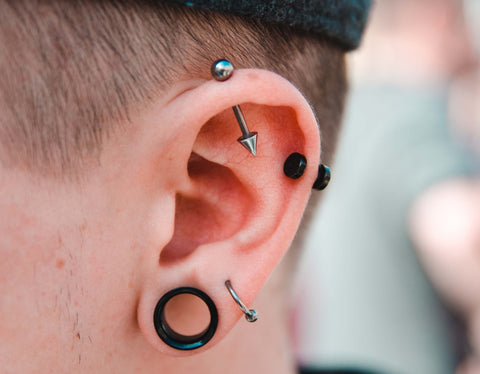What material are piercings made of? These are the most common materials

Photo: Kilian Seiler/unsplash.com
Piercings have been popular jewelry and an expression of individuality for centuries. Whether pierced ears, Nose rings, navel or Tongue piercings - they are widespread in today's society. But what materials are used for piercings, and which are the safest and best for the body? In this article, we take a look at the most common materials, their pros and cons, and tips on how to care for them.
Surgical Steel (316L)
Surgical steel, also known as 316L steel, is one of the most common piercing materials. It is characterized by its durability and corrosion resistance. This material is an alloy of steel, chromium and nickel, with the nickel content reduced to a minimum to avoid allergic reactions. 316L steel is affordable and comes in many shapes and sizes. It is suitable for most types of piercing and is often used for initial jewelry.
Titan
Titanium is an excellent material for Piercings, as it is light and hypoallergenic. It contains no nickel alloy, making it a great option for those with sensitive skin or nickel allergies. Titanium is also corrosion resistant and durable. It is often recommended for sensitive piercing sites such as cartilage piercings as it offers less chance of irritation or infection.
Bioflex
Bioflex is a flexible plastic material that has gained popularity in recent years. It's biocompatible, meaning it's less likely to cause allergic reactions. Bioflex is also very flexible, making it ideal for certain types of piercing such as lip or lip piercings Nose piercings because it is convenient and less disruptive. However, Bioflex is not as durable as metal and may fade or warp over time.
Niobium
Niobium is a relatively rare material for piercings, but it has a lot of positive properties. It is light, strong, hypoallergenic and corrosion resistant. Niobium comes in a variety of colors because it forms an oxide layer through anodization that colors the metal. Those with sensitive skin often appreciate niobium as an allergy-free option that allows for a wide range of jewelry styles.
18k gold
Gold is a classic jewelry material and is also used for piercings. 18k gold is a good choice as it has sufficient hardness and is less likely to cause allergic reactions compared to lower karat weights. It is important to ensure that jewelry is nickel free as this can cause skin irritation in some people.
plastic (acrylic)
Acrylic is another popular piercing material that comes in a variety of colors and shapes. It is lightweight and comfortable to the touch, making it particularly appealing to beginning piercing wearers. However, acrylic is not as durable as some other materials and can lose color over time from exposure to sunlight or detergents. It can also cause allergic reactions if inferior or impure variants are used. Therefore, it is important to choose high quality and hypoallergenic acrylic for piercings.
Silver
Silver is a traditional jewelry material, but it is not as commonly used in piercing as other metals. Pure silver is soft and bends easily, which is why it is often alloyed with other metals, such as copper, to improve durability. It is important to look for nickel-free silver to avoid skin irritation.
Material combinations and decorations
Some piercings consist of material combinations in which different metals or plastics are mixed together. For example, a piercing can be made of titanium with a gold accent or silver with a gemstone. It is crucial to ensure that all materials used are hypoallergenic and of high quality to avoid potential allergic reactions and infections.
Care and safety of piercing materials
Choosing a suitable material is crucial, but so is the right one piercing care plays an important role in the health and longevity of the jewelry. Here are some tips:
Regular Cleaning: Clean the piercing regularly with a mild, unscented soap and warm water. Avoid using alcohol or peroxide as these can dry out the skin and cause irritation.
Proper Placement: Have your piercing placed by a professional piercer who has experience and knowledge of proper placement. Improper placement can lead to complications and increase healing time.
Avoid overuse: Don't pull, twist, or move your piercings unnecessarily. This can delay wound healing and increase the risk of inflammation.
Use high-quality jewelry: Invest in high-quality jewelry that is suitable for body jewelry and does not contain any harmful substances.
Stick to Healing Times: Leave the piercing alone for the recommended healing time to allow the wound to fully close.
